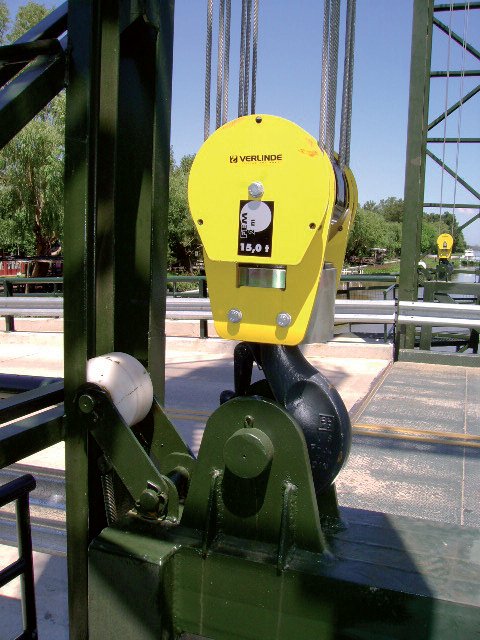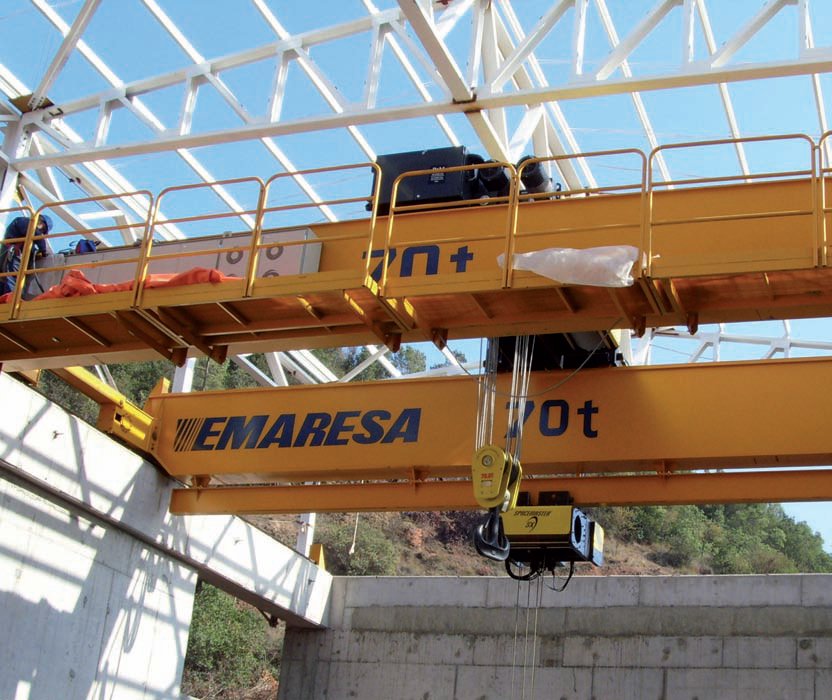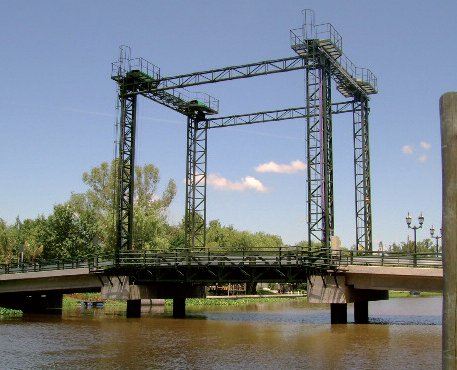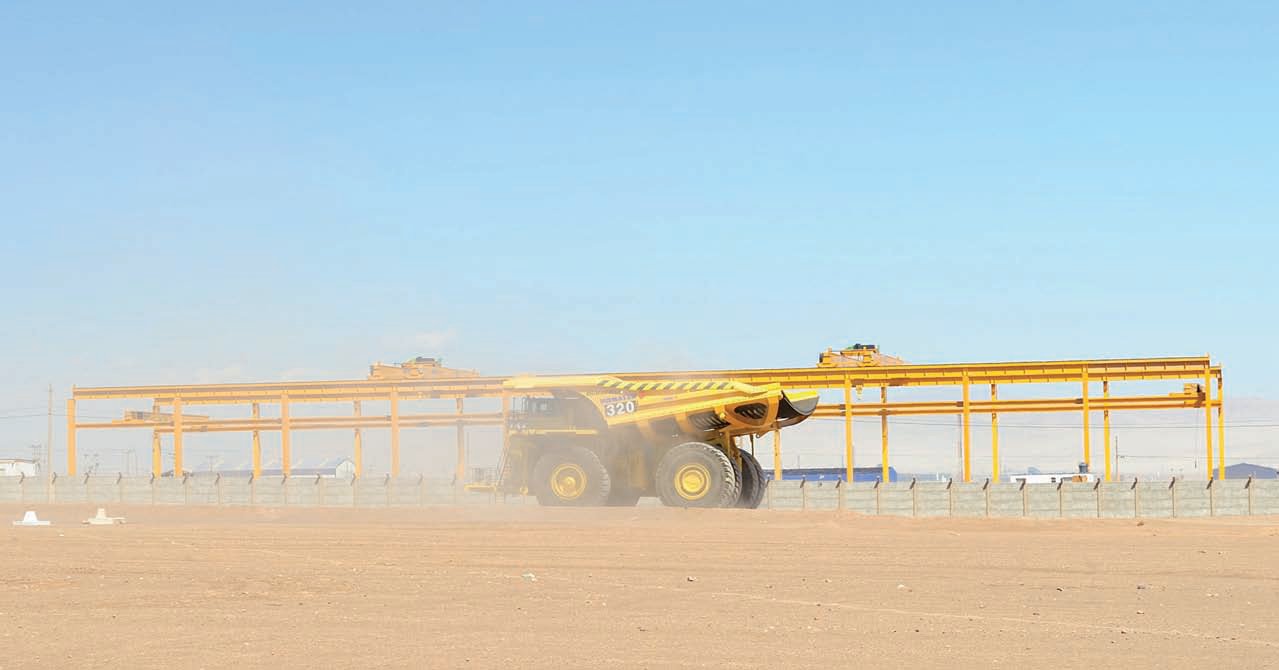Mellowed fervor
13 August 2012One year ago, Phil Bishop reported on these pages how the crane industry was full of excitement about South America. In a follow-up report, he finds that the tone has softened a little as trade restrictions start to emerge.
If the key words to this magazine's report on South America in 2011 were optimism and excitement, then in 2012 they have been replaced by hesitation and uncertainty.
South America remains a growth region in a largely economically stagnant world, and thus merits close attention. But it is not clear quite how the fall-out from the Euro crisis will impact upon the region. On the one hand Spanish investors, in particular, are turning to South America as a safe haven. On the other hand, Spanish banks have been teetering on the brink and continue to look far from secure. It is not certain that European investment, which has helped to create the South American boom, will continue.
Equally uncertain is how receptive the political climate will be to unfettered capitalism and free trade. There have long been both formal and informal trade barriers to negotiate in South America, and different ones for different countries, but there are signs that they are getting more difficult.
Venezuela under the socialist government of Hugo Chávez has not been an easy place for foreign firms to exploit. Now, this year has seen Argentina introduce import restrictions in a bid to tackle its rampant deficit. In April, the Argentinian government took over ownership of oil firm YPF, which was majority owned by Spanish energy company Repsol. YPF provides a third of Argentina's oil and a quarter of its gas.
In May, Argentina's mining ministry issued an edict that local products and services must take precedence over imported goods. Any imported goods and services now required government approval 120 days in advance. European Union trade commissioner Karel De Gucht was prompted to complain to the World Trade Organization (WTO). "Argentina's import restrictions violate international trade rules and must be removed. The trade and investment climate in Argentina is clearly getting worse. This gives me no choice but to challenge Argentina's protectionist import regime and ensure that the rules for free and fair trade are upheld," said De Gucht.
Karsten Hönack, Stahl CraneSystems regional sales manager for Latin America, says that Argentina had always been a quite difficult market because of competition from local hoist producers, but now the borders are effectively closed he says. "Every order we get from Argentina has to be personally signed by a government employee to allow it to be imported," says Hönack.
In Argentina, Stahl has two agents: Jonach and Forvis. Forvis manufacturers its own hoists as well as offering imported ones so it does not suffer so much when the borders are closed.
Hönack fears for the possibility that Brazil or Peru or smaller countries like Ecuador could follow Venezuela and Argentina down a populist protectionist path. He understands the attractions. Argentina has had to restrict imports because its deficit has grown so much but it cannot get credits and cannot borrow.
"Argentina is isolating itself but not necessarily in a bad way. They are trying to self-heal. However, it could take 10 years," he says.
Brazil has already had its disagreements with China that threatened trading relations but the two countries signed a trade agreement in April to keep business flowing.
Jeff Brazwell, director of sales for Latin America at US supplier R&M Materials Handling, also sees signs of change ahead but, so far at least, any negative impact has been modest. Sales continue to grow, although the rate of growth has slowed.
"Despite storm clouds on the horizon relating to the European crises and the possible spill-over effects on Latin America, business for R&M in this region has continued to be very strong indeed," Brazwell says. "Our 2010 sales in the Latin American region (including Mexico) were
up about 50% over 2009, and our 2011 sales ended up about 50% over 2010 levels. Although it is getting harder to predict, I think we can safely say our 2012 sales to Latin America will be at least 25% over the record levels we experienced last year.
"While we face exchange rate headwinds in some countries like Brazil, and the uncertainty mentioned above, I still think the economic tailwinds are strong enough to carry us through. We have seen a slight slowdown in the rate of growth of demand for cranes in some countries, but it is growth, nonetheless. And that is a lot more than can be said for a lot of the world right now.
"Yes, the future is somewhat uncertain, but the economic fundamentals in Latin America have not changed significantly in the past year, and in some countries like Colombia, they have actually improved."
The prospect of European investment in South American projects starting to dry up is not the only risk from across the Atlantic that Brazwell worries about. There is also the prospect of European hoist manufacturers getting desperate. "One area of concern is that certain European hoist manufacturers, faced with deteriorating economies back home, will become increasingly active in export markets, leading to further price erosion in the Latin American markets," he says.
A year ago we reported how Kito of Japan was reorganising its market strategy in South America, putting its sales and service effort through its US subsidiary Harrington Hoists rather than trying to run everything from Japan. With the exception of Brazil, which is handled by a separate subsidiary Kito do Brasil, that is now all in place. "Everything now comes out of the Harrington factory, under the Kito Americas name, and all Kito distributors now come through us," says Carlo Lonardi, chief operating office of Harrington Hoists.
"The response has been fantastic from our partners that were already established there," Lonardi says. "We have the same time zones and operating hours, pretty much, which has been a huge advantage. We have had some real nice advancement in business. Business is tracking up about 25% and it's just getting started. I am real excited.
Existing customer relationships, such as that in Chile with mining equipment producer Kubota, have been cranked up "to a new level", says Lonardi.
Harrington has invested in additional Spanish speaking staff in Pennsylvania and now has some of the team working on Portuguese lessons to support colleagues at Kito do Brasil. "We are definitely in it for the long run," Lonardi stresses.
Even Argentina is showing some promise, he says. "We are just getting started with Argentina. It's a little tougher because of the trade regulations but it's coming along slowly."
For both Kito and Stahl, Chile remains one of the better markets. Hönack attributes Stahl's success in Chile to strong teamwork between manufacturer and local representative. Gonzalo Fredes was "a humble salesman" when Hönack contacted him in 2003 and persuaded him to become Stahl's agent for Chile. In less than 10 years, Fredes -- backed by Stahl all the way -- has built up his company Fiefre SA from a sales representation office to a full crane manufacturing and service company with 65 employees and ISO 9001 certification. Fiefre started out by taking on maintenance services for Stahl hoists in the mining industry and developed from there.
In Chile, Hönack says, industry is all very 'vertical'. Except for the wine industry - where there is not much call for cranes - just about everything else relates either to paper, mining, or the mining supply chain. Caterpillar, for example, and its distributor Finning are very active in Chile as providers of machinery and maintenance to mining contractors. Stahl has integrated regional players. "All green hoists," is how Hönack describes Caterpillar Peru and Chile.
Brazil is the largest economy in South America by some distance but remains a difficult market to crack for money. This is partly due to local regulations, partly due to strong local producers, and perhaps also partly due to it being Portuguese speaking rather than Spanish.
Hönack says that there are a lot of regulations and conditions to satisfy in Brazil, meaning that it can take five years to get a company up and running, by which time the regulations and market
conditions may have changed again significantly. Any forecasts used to justify investment are almost certain to be wrong. "There are too many variables to make any realistic targets to work towards."
Stahl started to manufacture hoists in Mexico and Brazil in the 1960s, in joint venture in Mexico and alone in Brazil. It pulled out of Brazil in the early 1990s when the economy went bad. Now there are a lot of local manufacturers of hoists based on 40-year-old Stahl technology, he says.
Ten years ago Stahl briefly tried to reopen a sales operation in Brazil but pulled out again in 2003. In its wake Stahl Tahlas was established, distributing Stahl equipment and producing cranes at a factory in Itapecerica da Serra, São Paulo.
Stahl Tahlas director Sandro Galtieri says that industrial investment in Brazil appears to becoming more focused on fewer but larger projects. Stahl Tahlas is supplying all the materials handling equipment for a new Iveco plant in Sete Lagoas, Minas Gerais. This factory is
producing the new Guarani amphibious military vehicle developed by Iveco in partnership with the Brazilian army. Other recent crane installations by Stahl Tahlas include a new production line at a Cebrace glass factory in in Jacareí, São Paulo, which will produce 900t of glass per day, and a new steel tubes factory for Companhia Siderúrgica Nacional (CSN) supplying the offshore industry.
After mining and minerals extraction industries, the offshore sector is one of the most important markets for crane and hoist producers in South America. Oil and gas is a major resource here.
Jeff Brazwell says that R&M has lately made a big push with its explosion-proof equipment, not just into the oil and gas companies but also to the mining applications that require it.
Hönack says that Stahl does not do so well in this segment as it does in other parts of the world because of the dominance of American standards. US regulations on explosion proofing are
deeply ingrained, for example, in big Latin state oil companies like Petrobras and Pemex. Dominant lifting brands for explosion proof hoists, therefore, tend to be Yale, Ingersoll Rand and, to a lesser extent, Detroit Hoist, he says.
The standards are still based on mechanical technology considered by most Europeans to be out of date, making no provision for the not-at-all new development of electrical technology. Thus Weston brakes continued to be specified over conical rotor brake motors, for example, he says. But although US norms have long been dominant in South America, there has been some movement towards international standards over the past five to 10 years, he says.
"There is still a market for us," Hönack says. "We are coming up the stairs and making a huge effort at the moment. We are talking to Petrobras a lot about international regulations. They have to change."
Brazwell sees it slightly differently but agrees that US influence is declining. European-owned but US-based, R&M can meet both American NEC norms and European IEC/ATEX norms and experiences demand for both. "In Latin America you have the big oil companies like Pemex, PDVSA, Petrobras, plus the multinationals from the US and Europe, that use explosion-proof equipment," he says.
"Besides those big oil companies, you also have all the companies that supply to them who often buy Ex-proof equipment as well. We sell to both types of customers and we have sold both US and European norm equipment to them. We give the customer whatever the spec calls for and we don't really have a preference for one norm over the other." Both offerings are based on its standard Spacemaster SX hoist platform.
Brazwell adds: "In general, the farther you get away from the US, the less influence you see on norms, etc. I have seen more acceptance of the IEC norms lately. The load brake design is not seen in specs that much anymore."
The explosion-proof market in Brazil is dominated by local producers, he says, and Brazil has its own norms that must be met. The continuing rise of the Brazilian economy is taken as a given among business commentators. Whether it can carry the entire South American continent with it is not so certain, given the uncertainties in Europe.
Hönack has a unique perspective of the region, as a German national, born in the USA who grew up in Mexico. He predicts a rocky ride ahead for South America but is sure that it will win out in the end. "Ultimately, South America has better prospects than Europe," he says. "The old industrial economies are not flexible enough to adapt to the hurricane."
He adds: "South America is like an Advent Calendar. We have windows that open and windows that close. We don't know when a window will open or when a window will close. We know only that we have to be there when a window opens."
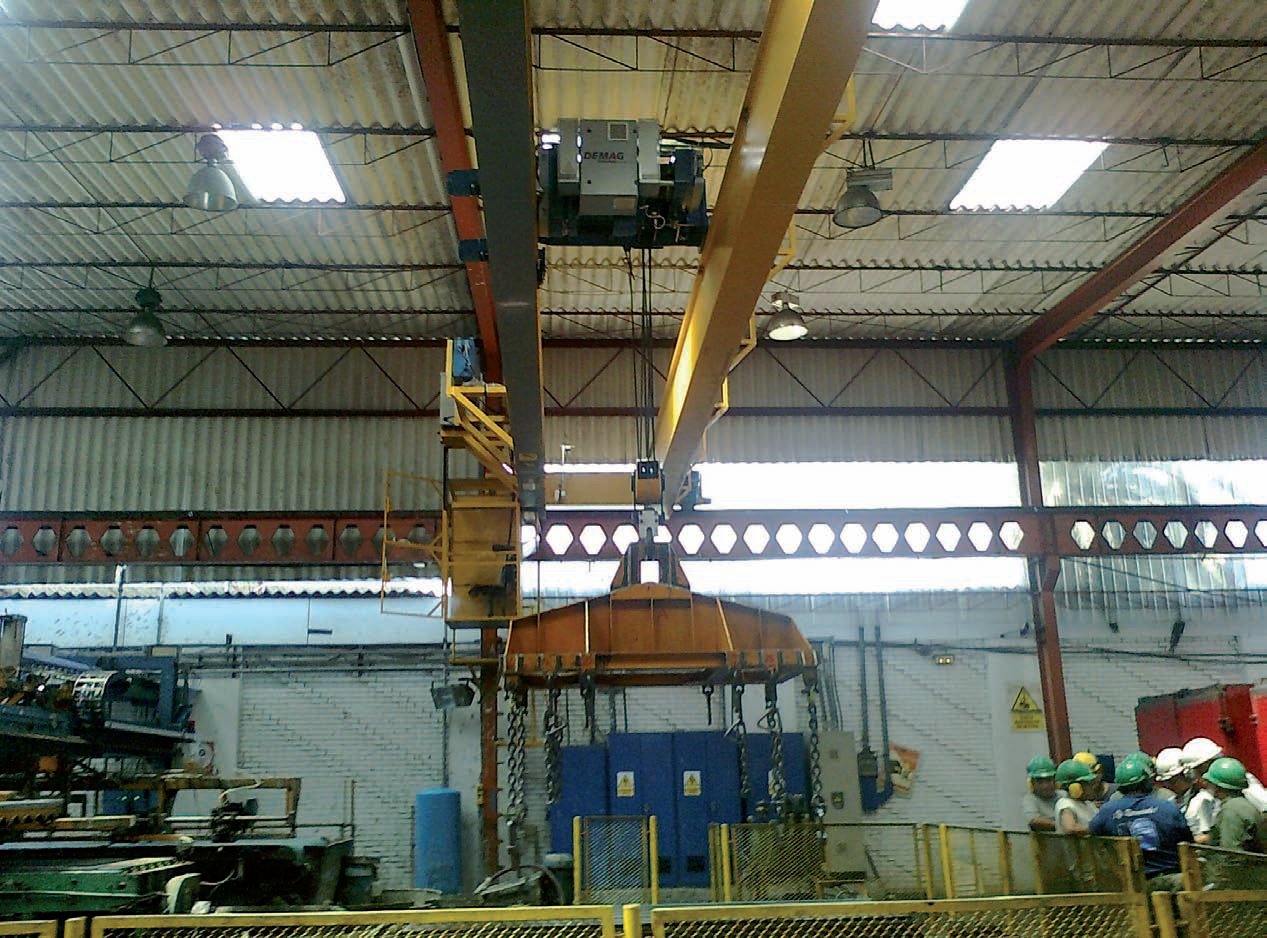 Demag's Peru and Chile subsidiary Fesanco provided an 8t crane on 15m double rails to Fabrica Peruana Eternit for production of construction products. Frequency inverters were used to guarantee precise placing.
Demag's Peru and Chile subsidiary Fesanco provided an 8t crane on 15m double rails to Fabrica Peruana Eternit for production of construction products. Frequency inverters were used to guarantee precise placing.
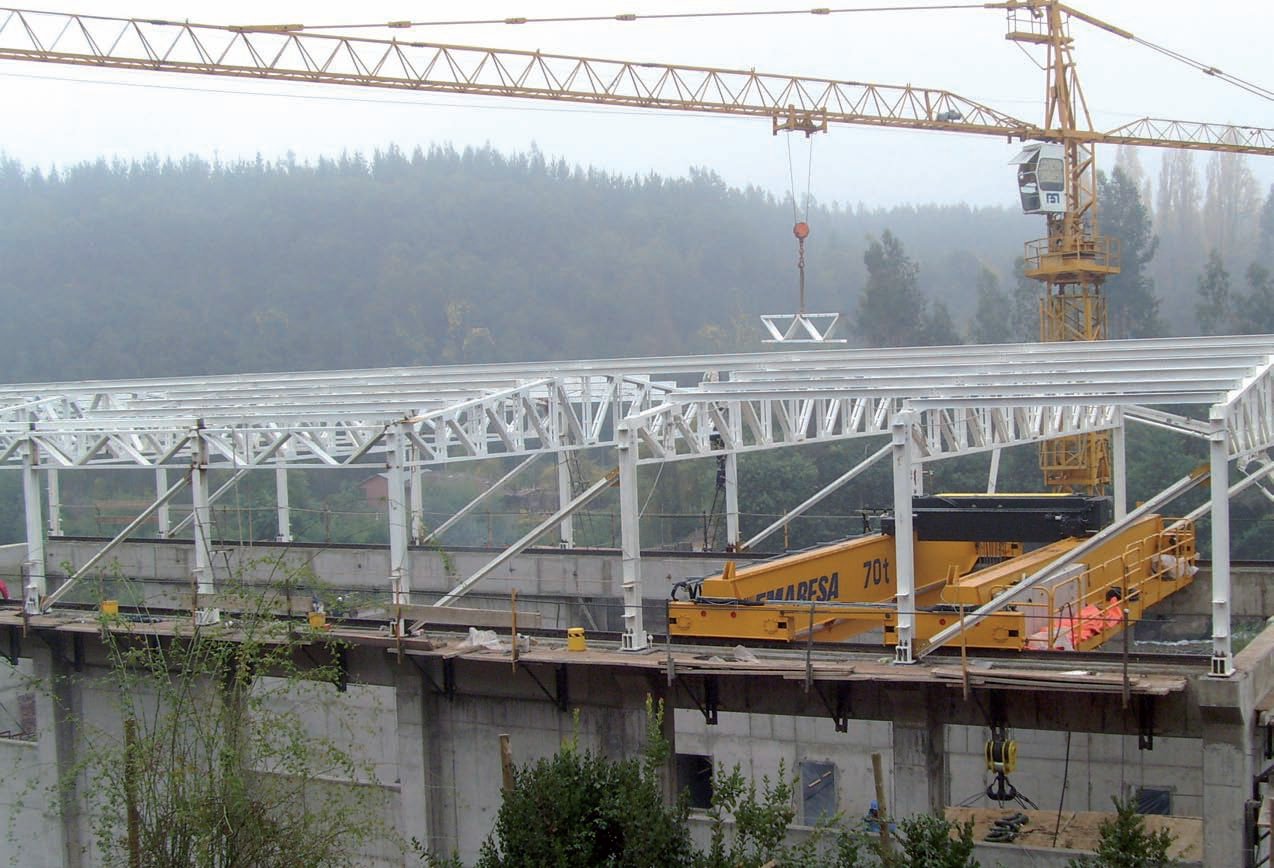 At the Hidromaule hydroelectric power plant in Talca, Chile, R&M’s distributor, Emaresa, based in Santiago, Chile, installed this 70t double girder crane with a 5t auxiliary under-hung hoist.
At the Hidromaule hydroelectric power plant in Talca, Chile, R&M’s distributor, Emaresa, based in Santiago, Chile, installed this 70t double girder crane with a 5t auxiliary under-hung hoist.
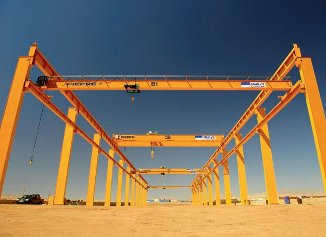 Two 50t and 5t bridge cranes with Stahl SH wire rope hoists are used in the Atacama Desert in Chile, the driest desert on earth, in the maintenance of dump bodies.
Two 50t and 5t bridge cranes with Stahl SH wire rope hoists are used in the Atacama Desert in Chile, the driest desert on earth, in the maintenance of dump bodies.
